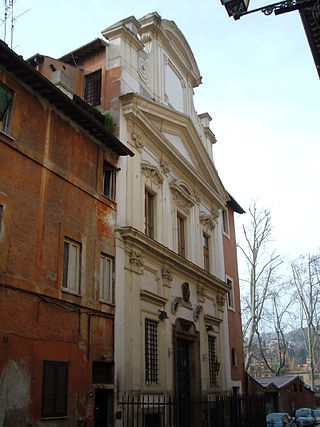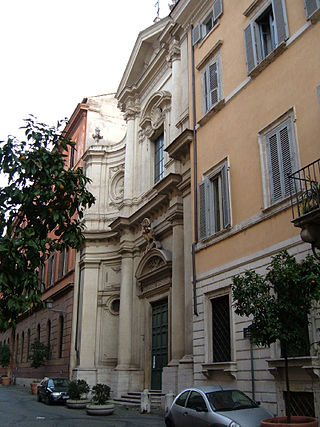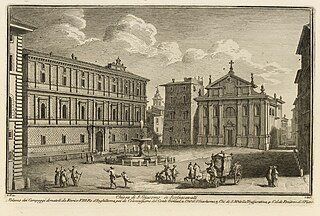
Ponte is the 5th rione of Rome, Italy, identified by the initials R. V, and is located in Municipio I. Its name comes from Ponte Sant'Angelo, which connects Ponte with the rione of Borgo. This bridge was built by Emperor Hadrian in 134 AD to connect his mausoleum to the rest of the city. Though Pope Sixtus V changed the rione limits, so that the bridge belongs now to Borgo, not to Ponte anymore, the area has kept its name and a bridge as its coat of arms.

Regola is the 7th rione of Rome, Italy, identified by the initials R. VII, and belongs to the Municipio I. The name comes from Arenula, which was the name of the soft sand that the river Tiber left after the floods, and that built strands on the left bank.

The Via Giulia is a street of historical and architectural importance in Rome, Italy, which runs along the left (east) bank of the Tiber from Piazza San Vincenzo Pallotti, near Ponte Sisto, to Piazza dell'Oro. It is about 1 kilometre long and connects the Regola and Ponte Rioni.

The Oratorio del Gonfalone or Oratory of the Banner is a building in Central Rome which once housed a Catholic fraternity. Since about 1960 it has served as a concert venue for the Roman Polyphonic Choir.

The Oratorio del Santissimo Crocifisso or the Oratory of the Most Holy Crucifix is a building in central Rome, Italy. Connected to the nearby church of San Marcello al Corso, it houses the Crucifix of San Marcello and served as a chapel and meeting place for the Archconfraternity of the Most Holy Crucifix devoted to the image. It is best known, like the Oratorio del Gonfalone, which shares the same artists, for its Mannerist decorations.

Santa Maria dell'Orazione e Morte is a church in central Rome, Italy. It lies on Via Giulia between the Tiber and the Palazzo Farnese.

A confraternity is generally a Christian voluntary association of laypeople created for the purpose of promoting special works of Christian charity or piety, and approved by the Church hierarchy. They are most common among Catholics, Lutherans, Anglicans, and the Western Orthodox. When a Catholic confraternity has received the authority to aggregate to itself groups erected in other localities, it is called an archconfraternity. Examples include the various confraternities of penitents and the confraternities of the cord, as well as the Confraternity of the Holy Guardian Angels and the Confraternity of the Rosary.

La Chiesa di San Rocco is a Roman Catholic building that is part of the Parish of Saint Giacomo. The original conjoined building dates from 1499 and is located at 1 Largo San Rocco, Rome.
The Archconfraternity of the Most Precious Blood was founded by Francesco Albertini, canon of the Basilica di San Nicola in Carcere, Rome, in 1808.

Confraternities of penitents are Christian religious congregations, with statutes prescribing various penitential works; they are especially popular in the Catholic Church. Members of the confraternities of penitents practice mortification of the flesh through fasting, the use of the discipline, the wearing of a hair shirt, among other instruments of penance, etc.

The Santa Maria Maddalena is a Catholic church in Rome, Italy dedicated to Saint Mary Magdalene. It is the conventual church of the adjacent General Curia of the Clerks Regular, Ministers to the Sick (Camillians), the world headquarters of the order. Located on the Via della Maddalena, one of the streets leading from the Piazza della Rotonda and the Pantheon in the Campo Marzio area, it is also Romes regional church for the people of Abruzzo.

The Church of Saint Lucy in Selci is an ancient Roman Catholic church, located in Rome, dedicated to Saint Lucy, a 4th-century virgin and martyr.

Santa Maria della Quercia is a Roman Catholic church located on the piazza of the same name, one block southeast of the Palazzo Farnese in the Rione (district) of Regola of central Rome, Italy.

Paolo Mei was an Italian painter active in Rome.

Santi Quaranta Martiri e San Pasquale Baylon is a Franciscan Catholic church, built in a late-Baroque style, located on Via San Francesco a Ripa in the Rione Trastevere, Rome, Italy.

Santa Maria Odigitria, sometimes Santa Maria dei Siciliani, is a Roman Catholic church in Rome, located at civico 82 on via del Tritone in the Colonna district.

San Giovanni Decollato is a Roman Catholic church in Rome, sited on via di San Giovanni Decollato in the Ripa rione, a narrow road named after the church. Its construction took most of the 16th century.

Santa Caterina da Siena is a church in Rome dedicated to Catherine of Siena. It is sited on via Giulia in the Regola district.

San Giacomo Scossacavalli was a church in Rome important for historical and artistic reasons. The church, facing the Piazza Scossacavalli, was built during the early Middle Ages and since the early 16th century hosted a confraternity which commissioned Renaissance architect Antonio da Sangallo the Younger to build a new shrine. This was richly decorated with frescoes, painted by mannerist artist Giovanni Battista Ricci and his students. The church was demolished in 1937, when Via della Conciliazione was built and the piazza and central part of the Borgo rione were demolished. Many decorative elements still exist, since they were preserved from demolition.

San Michele Arcangelo ai Corridori di Borgo was a church in Rome dedicated to St. Michael, the Archangel, important for historical and artistic reasons.





















